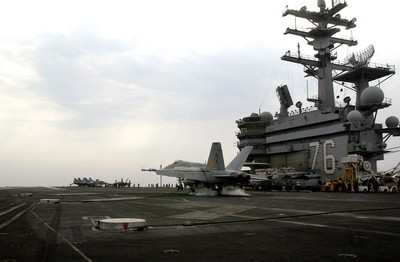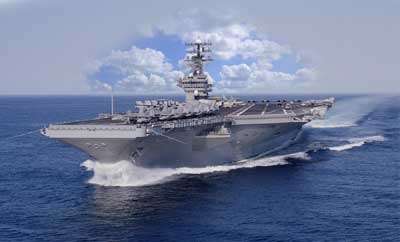Wed, Nov 21, 2007
Enables Safer Aircraft Carrier Landings
Northrop Grumman recently deployed the first
digitally-controlled arrestment system, which the company says
dramatically upgrades the critical process of "catching" aircraft
on carriers.

The Advanced Recovery Control (ARC) system was deployed on the
USS Ronald Reagan (CVN-76) aircraft carrier and performed its first
successful operational arrestment at sea on November 5. ARC was
designed and developed by an integrated product development team
consisting of Northrop Grumman's Power/Control Systems business
unit, Naval Air Systems Command, Aircraft Launch and Recovery
Equipment Engineering and Test, and NDI Engineering Company.
ARC is the Navy's first electronic digital control system for
aircraft arrestment. Awarded to Northrop Grumman as the prime
contractor, the program includes design, development, first article
qualification and production. After a successful development and
test program, the ARC system was granted Milestone "C" approval to
proceed with production in June 2006.
ARC installation began in July 2007 on the first of 10 aircraft
carriers scheduled to receive the upgrade. ARC is a key part of the
Navy's plans for extending the service life of carriers and
allowing for arrestments of heavier aircraft entering the fleet.
NAVAIR plans to retrofit ARC on Nimitz-class carriers and also
deploy it at three shore-based training facilities.
ARC is an upgrade to the existing MK 7 arrestment system. It
uses a precision digital control system to replace the existing
maintenance-intensive system of chains, cams and levers to close
the constant run-out valve. ARC uses a computer system with
feedback and built-in redundancy to accurately and safely arrest
the aircraft on the carrier's deck. The ARC upgrade includes
digital controls, software, graphical displays, programmable
arrestment profiles, and redundant electronically-controlled
actuators that precisely control the arrestment process.

"This milestone represents the first shipboard
software-controlled aircraft arrestment in naval aviation history,"
said Ed Tipton, Northrop Grumman's ARC program manager. "The
equipment worked 'right out of the box,' which underscores the
precision development of this groundbreaking system."
More News
Light Gun A handheld directional light signaling device which emits a brilliant narrow beam of white, green, or red light as selected by the tower controller. The color and type of>[...]
"The journey to this achievement started nearly a decade ago when a freshly commissioned Gentry, driven by a fascination with new technologies and a desire to contribute significan>[...]
Aero Linx: JAARS, Inc. For decades now, we’ve landed planes on narrow rivers and towering mountains. We’ve outfitted boats and vehicles to reach villages that rarely se>[...]
"Our driven and innovative team of military and civilian Airmen delivers combat power daily, ensuring our nation is ready today and tomorrow." Source: General Duke Richardson, AFMC>[...]
Aircraft Conflict Predicted conflict, within EDST of two aircraft, or between aircraft and airspace. A Red alert is used for conflicts when the predicted minimum separation is 5 na>[...]
 ANN's Daily Aero-Term (04.20.24): Light Gun
ANN's Daily Aero-Term (04.20.24): Light Gun Aero-News: Quote of the Day (04.20.24)
Aero-News: Quote of the Day (04.20.24) ANN's Daily Aero-Linx (04.21.24)
ANN's Daily Aero-Linx (04.21.24) Aero-News: Quote of the Day (04.21.24)
Aero-News: Quote of the Day (04.21.24) ANN's Daily Aero-Term (04.21.24): Aircraft Conflict
ANN's Daily Aero-Term (04.21.24): Aircraft Conflict




